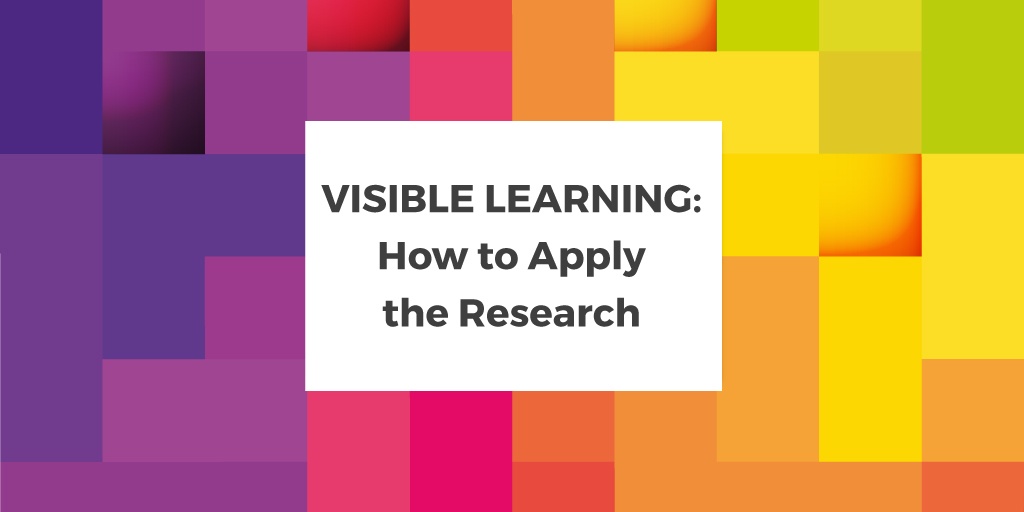
Professional educators should always seek out best practices. Because this term is thrown around a lot, teachers can feel confused and overwhelmed by all the “research” that is available about what we should do (or not do) in our classrooms. It can make our collective heads spin.
One solution to assist teachers with this is John Hattie’s research on Visible Learning. This resource can be very beneficial in keeping our heads on straight, but Visible Learning can be a bit overwhelming, too. There are 252 different categories of research sorted into a number of domains and subdomains. This is a lot of information to sift through, and if you’ve read the book, it is a formidable experience.
I think this same feeling of being overwhelmed is familiar to many teachers. Where do we start? What is most important? What is least important? Which strategies should we try first? Which are the easiest? Which are the cheapest? Again, our heads spin.
Simplifying the Research
So, here is an approach to help keep it simple—or at least manageable—for teachers to understand. In the table chart available on the Visible Learning website, it breaks down the different areas, and the research is sortable by that area. If a teacher wants to focus on teaching, leadership, or prior background knowledge, they can sort the sheet for that area to see which of the indicators have the largest effect size (ES).
Because the scope of his work is vast and deep, there isn’t room here for a full, in-depth analysis of all of it. In order to demonstrate the overarching ideas and give teachers a taste of how the research looks, here is a specific focus on an instructional area.
For this specific area, “Strategies Emphasizing Feedback,” we can unpack the specifics and see how we could use it to see what to do, and what not to do, based on research and best practices. Each topic listed here has a title, the number of its overall ranking, and then the effect size (ES) impact that the meta-analysis showed. The higher the ES, the more effective the strategy. An ES of 0.40 or higher is considered an effective practice, or one that will make a difference with student engagement.
- Response to intervention (#5, ES 1.29): This is the number five overall strategy that can impact student achievement, so it is considered very powerful. The response to intervention system, or RTI model, is a system-wide approach to putting students in tiers to meet their needs. Students with the most needs receive the most amount of intervention.
- Classroom discussion (#15, ES 0.82): Discussions with students are typically higher level, engaging, and allow for critical thinking and speaking skills to be present. When students talk and write, they are thinking at a higher level than just listening and receiving knowledge.
- Feedback (#32, ES 0.7): Teachers providing feedback is one of Robert Marzano’s nine effective instructional strategies, which can be found in his Classroom Instruction that Works resource. Feedback to students should be specific, timely, and ongoing to be most effective.
- Formative assessments (#87, ES 0.48): Using assessments to guide instructional decisions has a positive impact on student learning. Formative assessments are more effective than traditional assessments at showing student achievement gains.
- Questioning (#88, ES 0.48): Like formative assessments (with the same effective size), questioning of students has a positive impact on student learning. Questioning at higher levels helps students to think critically. Plus, classroom discussions are more robust because of how the students are engaged.
- Different types of testing (#212, ES 0.12): Although this area is somewhat broad and non-descript, it sends a clear message to teachers. Tests don’t necessarily increase student achievement. As we think about this in the area of feedback, it makes sense. How many times are our classroom tests glanced at and thrown in the trash? Students don’t see tests as an opportunity to learn more, but a message that “learning has finished.” Formatives, classroom discussions, and feedback to students is much more impactful.
Though this small breakdown, I hope teachers can see how this research can form our instructional practices. Are we using the best strategies most frequently in our classroom? If we are not, why are we not? If we are, do we agree about the impact that these practices can have on learning? I would encourage educators at all levels to look more closely at the research from Visible Learning to help us all improve at our craft each and every day.
For more insightful teaching tips, and to stay up to date with the latest education news and trends, be sure to subscribe to our Educator blog



